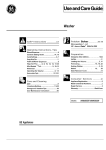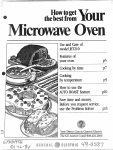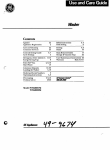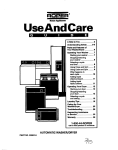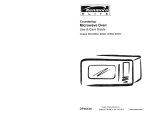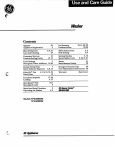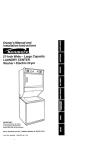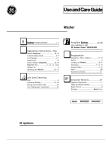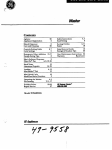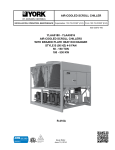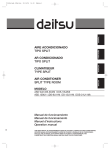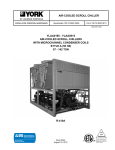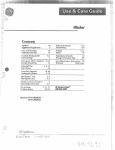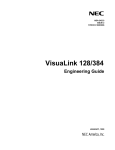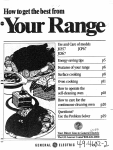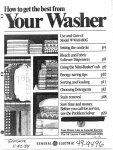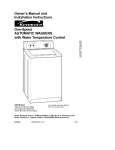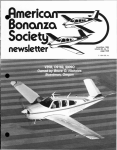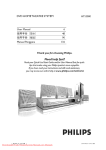Download GE WWP1180F User's Manual
Transcript
use
andcare
of
Space
tier
Wmhers
mPl170F
WPI180F
Ener~-savhg
Tips
-j@i
ProperSorthg
andLoatig
-@5
Detergentie
Selection
andUsage
p9
Stti Removal
,
::.
p14
Launderhg
Problems
andSolutions p18
SaveThe andMoney
Before
youcallfor
usetheProblem
Solver p22
semice,
.&
Your
Dinxt
Line
toGeneral
Electric
meGE Answer centeF800e626.200
—
.
- ,. ~+..%
*.%.
~.*
~.==+
:r~gFi3w=
.%”%%
%$’w~esaz$=i?
@F&3
]m~ixtgmt
Camrm
,
Emrgy’
3
swing
Tips
Readthis book carefully
4
CMmdSmling Means Better
~NashiRg
5
It Pays ToCMeckand
Pm-treat
5
Hwill help you operate and
maintain your new washer properly.
soaking
5’
Keep it handy for answers to your
questions.
C@eratingInstructions
63~ ‘
m your
F@tabk Washer-—— , ‘
,
Nk?dt?lWWPI17QF .,.
Operating !ns$ructiorw ‘
“ 8 “‘
for your
s’
Stationary Washer—
‘~~‘
, ,
Model VWNPl&OF’ ‘ --- ~~ , -~, -,
$i@xiai Flecqnmendatiohs b ~~43
Washing Permanent Press, d
without @ryer.‘.” ..:’:- ~ ::- :
F%&WTo CONder in’ - --~, .
Selection of Detergents-.. . .”,
and$oap-.
- . . ~ -’-’:
Q
.,
.,
if you don’t understand something
or need more help... Call, toll free:
The GE Answer i2enterT~
800.626.2000
siwvke
(xmstlrner
information
or, write (include your phone
number)
Consumer Affairs
General Electric Company
Appliance Park
Louisville, KY 40225
,1
~
, .“
HOwm use Detergem
HargiWatef-D;Y~u
- ‘W
‘-.
Haveii’?
.,
Iir.
.,
(Nw Latmdryl%ducts
‘
13.
M.,15
How W RemoveS;ains
~
W/ashing.Guidefor Different W3$
W
Fabrics and Loads’
CWmmn Laundering
Problems
1$3-220”
l-low T“ Care for YourWasher
21
Get %3Know YourWasher
-in”
The Problem Solver -
22
Ccmswm3rServices
23
2
A,
-
~e.--d
*=.
You’ll find them on a label located
on the lower left side panel near
the front.
These numbers are also on the
Consumer Product Ownership
Registration card that came with
your washer. Before sending in this
card, please write these numbers
here:
Model No.
Serial No.
Use these numbers in any
correspondence or service calls
concerning your washer.
Save time and money...
before you call for service
Check the Problem Solver (page
22). It lists minor causes of
operating problems that you can
correct yourse!f. It could save you
an unnecessary service tail.
“11-’
.
SWklklnumbers.
If you receive a damaged vtmher7
immediately contact the dealer (or
builder) that sold you the washer.
The !Xwnaginb Effects of,”, , - Ml :
CWtxmXe Detergents cm - ‘:
.-’
‘,r
Your Clothes and
VVaskier“”.’.
.“
,.
How IVh..@3
Detergenl . “
Should ~OU&#?
,.
write
dcwn the model and ;&g,
@
..
iYARN!NG–When
I.Jsingthk
appliance, always exercise basic
safety precautions, including the
fcdkmving:
~ L&K?this appliance only h’
intended purpose as described in
this Use and Care Book.
@This washer mustbe properly
!Ilstailed and ikmmxi
accordance with the installation
instructions ibekm it wed. If
you did not receive an Installation
Instructicms sheet with your
washer, you can obtain one by
contacting the service location
nearest you.
- Properly ground to conform
with ali governing codes
and ordinances.
- Install or store where it will not
be exposed to temperatures
below freezing or exposed to
the weather.
- Connect to a properly rated,
protected and sized powersupply circuit to avoid electrical
overload.
- Connect to adequate plumbing
and drain facilities as described
in the Installation Instructions.
= With stationary model, turn off
water faucets when the washer is
not in use to relieve pressure on
hoses and valves, and to minimize
leakage if a hose or valve should
break or rupture.
~ With portable model, turn
faucets off and disconnect hose
coupler when washer is not in use.
@When disconnecting this
appl!ance pull by the plug rather
than the cord to avoid damage to
the cord or junction of cord and
plug. Make sure that the cord is
located so that it will not be
stepped on, tripped over or
otherwise subjected to damage
or stress.
QWe strongly recommend that
any servicing be performed by a
qua!ified individual.
~ The wiring diagram for this
irnachine is located inside the
lower front access panel.
its
in
is
To minimize
the possibility
d
injury:
~ Do not mix chlorine bleach with
ammonia or acids such as vinegar
and/or rust remover. Mixing can
produce a toxic gas which may
cause death.
~ Do not wash or dry articles that
have been cleaned in, washed in,
soaked in, or spotted with
combustible or explosive
substances (such as gasoline,
degreasers, dry-cleaning solvents,
kerosene, etc.) which may give off
vapors that could ignite or
explode.
Do not add these substances to
the wash water.
Do not use these substances
around your washer and/or dryer
during operation.
@HYDROGEN GAS is produced by
the chemical action within your
water heater and the gas can
accumulate in the water heater
and/or water pipes if hot water has
not been used for a period of two
weeks or longer. HYDROGEN GAS
CAN BE EXPLOSIVE UNDER
THESE CIRCUMSTANCES.So tO
prevent the possibility of damage
or injury, if you have not used hot
water for two weeks or more, or
move into a residence in which the
hot water system may not have
been used for some time, turn on
all hot water faucets and allow
them to run for several minutes
before using any electrical appliance which is connected to the
hot water system. This will allow
any hydrogen gas to escape. Of
course, since the gas is flammable, do not smoke or use an
open flame or appliance during
this process.
~ !Neverreach into the washer
while parts are moving. Always
stop the washer to ioadj unload,
add forgotten items or add
additional laundry aids.
For your safety, the washer lid is
locked closed during spin cycle=TO
open lid during spin”cy~le, push
the timer knob IN and wait for lid
lock to release, about 30 seconds,
before opening.
At end of cycle lid iock will release
after about 30 seconds. The washer
will fill and agitate with the lid
open.
~ close supervision is necessary
if this appliance is used by or near
children. Do not allow children to
play inside, on or with appliance or
any discarded appliance. Dispose
of discarded appliances and shipping or packing materials properly.
Before discarding a washe~ or
removing from service, remove the
washer lid.
* Never operate portab!e model in
locations where it could conceivably create a hazard, such as top
of stairs or edge of unguarded
landing.
@Keep all laundry aids (such as
detergents, Meaches, fabric
softeners, etc.) out of the reach
of children, preferably in a locked
cabinet. Observe ail warnings
on container labels to avoid
personal injury.
@Keep the area around and underneath your appliances free from
the accumulation of combustible
materials, such as lint, paper, rags,
chemicals, etc.
@Keep the floor around your
appliances clean and dry to reduce
the possibility of slipping.
@To minimize the possibility of
electric shock, unplug this appliance from the power-supply before
attempting any maintenance or
cleaning (except the removal and
cleaning of the lint filter).
NOTE Turning the Cycle Selector
to an OFF position does NOT
disccmnect the appliance from the
power-supply.
Continued next page
Q Do
riot
tamper
With controls.
QDO no$operate this appliance if
it is damaged, malfunctioning,
partially ciisassemb!edf or has
missing or broken parts, including
a damaged cord or piug.
= Do not wash fiberglass articles
in your washer. Skin irritation
ccmid result from the remaining
particles that may be picked up
by clothing during subsequent
washer use.
e The laundry process cafl redl~ce
the flame retardancy of fabrics. To
avoid such a result, the garment
manufacturer’s care instructions
should be followed very carefully.
open lid during spin cycle, push
the Cycle Selector N and wait for
iid lock to release, about 30
seconds, before opening.
@Never climb on or stand on the
washer top.
At end of cycle, lid lock will
release after about 30 seconds.
For washer
operation
~ Do not leave washer lid up
during cycle. The washer will fill
and agitate with the lid open.
For your safety, the washer lid is
locked closed during spin cycle. To
~ 50 NOT CHANGE CYCLE OR
MANUALLY ADVANCE CYCLE
SELECTOFtWHEN DIAL 1SOUT
Push in Cycle Selector and wait for
washer to stop. Then select new
Cycle and pull Cycle Selector to
restart.
optional Accessories for
ycwrSpaeemakers
May be W3edwith
Mode!
Number
Stationary
Washer
WWP1180F
Description
‘Portable
Washer
Stationary
Dryer
WWWPI-170F DDP1280F
Portable
Dryer
Stationary
Dryer
DDP%?70F
DDPW7’5F
WMK-30
VVall-MoLmtInstallation Kit. Use to
mount dryer to wall above washer.
DSR-80
Dryer Stack Rack. Supports dryer
in stacked installation.
x
x
x
VVDF430* Washer/Dryer Frame for unitized
installation. Use to mount dryer on
top of washer.
x
x
x
x (1)
DSR-70
Dryer Stack Rack.
x
WPFWI
Conversion Kit. To convert washer
to built-in installation.
x
x
x (1)
x
x (1)
x
I
Accessories are available from your dealer or service organization.
(1) May use WMK-25
*Wi—t-White
AD—Almond
We are all conscious of the need
to save energy—to protect our
country’s energy reserves and to
help us save money. There are
several things you can do to
reduce the amount of energy
needed to wash your clothes:
1. Use Hot Wash—~40° (60”C)—on
a regular basis on/y when washing
headily soiled articles—such as
work and play clothes.
2. Lhcier normal soil conditions,
wash in water above 80°F (27*C).
This generally means using the
VYa.rmWash temperature setting
cm your washer—temperatures
approximately 95°F (35°C). If you
notice that soil has accumulated
after several consecutive
washings, use Hot Wash
occasionally, if safe for fabrics.
3. Always rinse in Cold Water. The
temperature of the rinse does not
affect cleaning.
4. Try to wash less often. Save
articles of the same type of fabric
until you have a fuil load.
5. If you must wash smaller loads,
adjust the amount of water. Small
loads should have lower water
levels.
4
& Wash in off-peak utility hours.
Your local utility can tell you which
are the off-peak hours.
IMPORTANT NOTE: if your clothes
and household items don’t look
clean and fresh after washing,
what are you apt to do? You will
probably then re-wash them... and
that means you’ll waste energy.
Remember to sort your clothes
carefully, and load them properly,
select correct cycles, use enough
detergent and choose a water
temperature warm enough to
release and get rid of soii.
Goodsorting
means
better
washing
n
He&
m
sortbysurface
texture sortbysoil
Separate
Separate
.
Lightly
Soiled
from
from
Medium
Soil
17
from
9
LINT COLLECTORS—such as rnanrnade fibers and napped fabrics
like velveteen and corduroy—
attract lint. These must be washed
separately.
sort
Scwt
by‘fabric
Separate
m
s
Cottons &
Linens
from
by
color
17
s
Whites
n
from
●
\
Permanent
Press &
Blends
from
Lights
Synthetics &
Poiy Kriits
r7
from
from
.
Delicates
--
In addition to sorting to reduce lint
collection, it is recommended that
fabrics of similar construction be
washed together whenever possible.
@Remove stains. FOR STAIN
REMOVAL CHART, SEE PAGE 14.
@Pre-treat heavy soil by rubbing in
a small amount of liquid detergent
or a paste made of water and
powdered detergent or soap.
For best results wait % hour
before washing.
Soaking—agood way
to kmsen deep soils
and stains
A thorough soaking with detergent
or special soaking agent is an
excellent way to remove heavy
soils, embedded dirt and even
some stains.
Soaking can be either a completely
separate washing step or a preliminary step to a complete wash cycle.
For detailed information on how to
soak in your washe~ see pages 7
or 8.
from
●
13
~ Do any necessary mending—
rips, hems, tears.
@Turn PolyKnits inside-out to
minimize fabric surface damage.
FOR MORE iNFORMATION ON
LNT’ CONTROL, SEE PAGE 48.
Separate
~ Empty pockets, brush out cuffs,
zip zippers, snap snaps, hook
hooks and button buttons.
@Check all items for areas of
heavy soil or stain.
●
LINT PFIOD1.JCERS-such as terry
toweling and chenille—give up lint.
h pays to dwc%
and b pre”treat
FOR INSTRUCTIONS oh!
AND !LCMms,
DIFFERENT
SEE PAGES f6 arid 17.
FABRICS
5
FOR NFORMATK3N ON Sf3AKNK?I
AGENTS, SEE PAGE fi3.
instructions
operating
YourPortableWasher— Model
WWPI170F
for
m
H
This washer may be used in tyvo
ways — as a portable or as a builtin washer. Chances are you will
first use it as portable and then
have it permanently installed at a
iater date. .
When using your washer as
portabie, roii it to the most ievei
position near the water and power
source. Once the washer is in
position press “Lock Lever” with
your foot (See illustration A) to
secure washer in position. Make
sure washer is firm to the fioor and
does not rock. Washer wiii not
move untii iever is reieased. When
you have finished washing, press
“Reiease Lever” (See illustration B)
and roii washer to your storage area.
How’to Load Your washer
‘set the Uxw”ok
~ Add measured amount of
detergent according to ioad size,
amount of soii and water ievei. See
pages 9 through 11for detaiied
information on types and amounts
of detergent.
See the Controis Setting Guide on
page Z
@Load ciothes iooseiy. Dry ciothes
ievel should be beiow bottom of
wash tub rim. Do not put ciothes
on top of the agitator or wind them
around it. For best resuits, mix
iarge items with srnaii ones. When
washing a single heavy item, such
as a shag rug or bedspread, add
one or two other pieces to baiance
the ioad. Large items shouid be no
more than one-half of the totai load.
@Ciean iint fiiter. Be sure fiiter is
cieaned before washing every
ioad. See page 21.
@See page 13 for instructions on
how to use bleach, fabric softeners
and other iaundry products.
ILLUSTRATION A–LOCK LEVER
Press “Lock Lever”- iever on right
to secure your washer in position.
~ Ciose iid. Washer wiii fiii and
agitate but wiii not spin with iid
open. This washer has a Safety Lid
Lock. As a safety measure the iid
wiii be automatically iocked during
the spin portion of each cycie. The
iid wiii automatically uniock about
30 seconds after the end of the
spin cycie. To open iid during spin
cycie, push Cycie Seiector iN and
wait for iid iock to reiease, about
30 seconds, before opening.
For your personal safety, never
reach into washer while parts are
moving. Aiways stop washer to
ioad, unioad, add forgotten items
or additional iaundry aids.
ILLUSTRATION B–
RELEASE LEVER
Press “Reiease Lever”—iever on
ieft before you attempt to move
washer,
6
m Seiect Water Levei
SMALL: Washer is iess than % fuii
of ciothes.
VARIABLE: Set between SMALL
and LARGE to adjust ioad sizes
between % and % fuii.
LARGE: Over 2A fuii.
if you wish to increase ievei after
you’ve made a seiection, turn knob
to “RESET” and seiect new ievei.
❑ Seiect Wash/Rinse Temperature
Set Wash/Rinse Temperature
switch at Warm/Warm (MANUAL)
and leave it at this setting. To
connect washer you must first
instaii a faucet adapter according
to the instructions inciuded with
the faucet adapter package. Grasp
coup!e~ puii hoses out of cabinet
untii red marker on hoses is
visibie.
Attach the washer’s hose coupier
to the faucet, (See illustration C).
c
ILLUSTRATION
Grasp white ring on hose coupier
and puii it down. Siip hose coupier
over faucet adapter and reiease
white ring. This”wiii connect hose
coupier to faucet adapte~ To test
the water temperature, press the
red button on the side of the
adapter. At the end of the wash
cycle turn off faucets, press red
button again to relieve pressure
and eliminate splashing. Do not
disconnect hose coupler until
pressure is relieved.
Set wash temperature at faucet.
Washer drains into sink. Be sure
sink drain is open to prevent
overflowing. Blend hot and cold
water in equal parts for WARM
WASH. After wash agitation has
started, change faucet settings for
your rinse water temperature. Be
sure to plug washer into a properlygrounded three-prong receptacle.
See your Installation Instructions.
controls
~ Push Cycle Selector in and turn
clockwise to your selected wash
cycle.
❑ Pull Cycle Selector out to start
the cycle. If you wish to change
cycle setting after washer has
started, push Cycle Selector in
and wait for washer to stop. Then
reset to the new position. Setting
can be changed at any time during
the cycle.
HUNV to soak h Yew’washer
Set WASH/RINSE TEMPERATURE
at WARfWWARfvl (MANUAL) and
adjust faucets for desired soak
temperature. Add detergent or
soak agent. Turn Cycle Selector to
desired cycle. Start the washer.
After washer fills and begins to
agitate, push in the Cycle Selector
to stop washer. Allow to soak for
as long as desired. After desired
soak, turn to the last Spin. Pull
out the Cycle Seiector to complete
the cycle.
setting
‘(3LMC!
Some adjustment to these recommendations may be desirable depending on your particular washing conditions.
Cottons & Linens
Permanent Press
Polyester Knits
Synthetics & Wends
Fabric
Work clothes,
dungarees, etc.
with heavy soil
Work clothes,
dungarees, etc.
with normal soil
White or
Colorfast
Bright
Colors
Heavy or
Oily Soil
Normal or
Light Soil
Heavy or
Oily Soil
Normal or
Light Soil
Wash/Rinse
Temperature’
Hot/Cold
Hot/Cold or
Warm/Cold
HotlCold or
Warm/Cold
Cold/Cold
Hot/Cold
Warm/Cold
Warm/Cold
Warm/Cold
Regular
,5
Regular
Regular
Regular
Perm, Press Perm. Press
Delicate
Delicate
15
15
10
12
Start
Start
Cycle
Cycle Selector
Setting
*For
portable, set at Warm/Warm (Manual) and leave it there.
8
operating
Instructions
for
Your
stationary
washer
— ModelWWPI180F
l-kwwto Load Yew’washer
~ Add measured amount of
detergent according to load size,
amount of soil and water level. See
pages 9 through 11 for detailed
information on types and amounts
of detergent.
~ Load clothes loosely. Dry clothes
level should be below bottom of
wash tub rim. Do not put clothes
on top of the agitator or wind them
around it. For best results, mix
iarge items with small ones. When
washing a single heavy item, such
as a shag rug or bedspread, add
one or two other pieces to balance
the load. Large items should be no
more than one-half of the total load.
~ Ciean iint fiiter. Be sure fiiter is
cieaned before washing every
ioad. See page 21.
~ See page 13 for instructions cm
how to use bieach, fabric softeners
and other iaundry products.
* Ciose lid. Washer will fiil and
agitate but wiii not spin with iid
open. This washer has a Safety Lid
Lock. As a safety measure the iid
wiii be automatically iocked during
the spin portion of each cycie. The
iid wiii automatically uniock about
30 seconds after the end of the
spin cycie. To open iid during spin
cycie, push Cycie Seiector iN and
wait for iid iock to reiease, about
30 seconds, before opening.
i% your personal safety, never
reach into washer while parts are
moving. Aiways stop washer to
ioad, unioad, add forgotten items
or additional iaundry aids.
setthe Ccmtrds
❑ Seiect Water Levei
SMALL: Washer is iess than % fuii
of ciothes.
MEDIUM: Between % and 2A fuli.
LARGE: Over % fuii of ciothes.
❑ Seiect Wash/Rinse Temperature
Coid rinse wiii be automatically
provided with aii cycies.
❑ Push Cycle Selector
in and turn
ciockwise to your seiected wash
cycie.
❑ Puli Cycie Seiector out to start
the cycie. if you wish to change
cycie setting after washer has
started, push Cycie Seiector in
and wait for washer to stop. Then
reset to the new position. Setting
can be changed at any time during
the cycle.
See the Controis Setting Guide
beiow.
Ckmtrds setting
Guide
Some adjustments to these recommendations may be desirabie depending on your particular washing conditions.
Cottons & Linens
Permanent Press
Polyester Knits
Synthetics
& B!encls
.
Fabric
Work clothes,
dungarees, etc.
with heavy soil
Work clothes,
dungarees, etc.
with normai soil
White or
Colorfast
Bright
Colors
Heavy or
Oily Soil
Normal or
Light Soil
Heavy or
Oily Soil
Normal or
Light Soil
Washll?inse
Temperature
Hot/Cold
Hot/Cold or
Warm/Cold
HotlCold or
Warm/Cold
CoId/Cold
Hot/Cold
Warm/Cold
Warm/Cold
Warm/Cold
Cycle
Regular
Regular
Regular
Regular
F’erm. Press
Perm. Press
Delicate
Delicate
15
15
10
12
8
Start
Start
Cycle Selector
Setting
1-
15
inYourwasher
HCw ‘to
Scmk
Set WASii/RiNSE TEMPERATURE
switch. Add detergent or soak
agent. Turn Cycie Seiector to
desired cycie. Start the washe~
After washer fiiis and begins to
agitate, push in the Cycie Seiector
to stop washe~ Aiiow to soak for
as iong as desired. After desired
soak, turn to the iast Spin. Puii
out the Cycle Seiector to compiete
the cycie.
8
—
-—
.
Special recommendations
for
washing permanent press
if ycwl do not have a dryers
If you are machine-washing Permanent Press clothes that you plan
to hang or drip-dry, use extra care
to minimize wrinkling in the wash
process:
~ Be careful not to overload
washer Permanent Press clothes
must have ample room to move
freely. A Medium size load is the
largest you should use for
Permanent Press.
@Use more water than you would
for a regular load. Use a Medium
Fill for a Small Load; a Full Fill for
a Medium Load.
@Remove clothes as soon as washer
stops and hang immediately.
Factorstoconsiderin selection
detergents
andsoap.
of
Products:
Advantages:
Disadvantages:
Phuxphate—
Powdered Detergents
Perform well in hard or soft
water.
Are not available in some
areas.
Wash all types of fabrics well.
Can be used in hot, warm, or
cold water.
Nm-PhosphatePowdered Detergents
Perform satisfactorily in soft
or moderately hard water.
Do not clean well in hard
water.
In some areas only nonphosphate products are
available.
May be difficult to dissolve,
especially in cold water.
Should not be used in cold
water.
Those containing sodium
carbonate as an ingredient
may cause harmful limestone
deposits on clothes and
washer when combined with
hard water. (See Page 10.)
Liquid
Detergents
Perform well in soft water.
Offer better performance in
hard water than powdered nonphosphate types.
May not perform as well as
powdered phosphate products
when diluted in wash water.
Clean synthetics and fabric
blends well.
Are excellent as concentrates
for removing spots.
Completely dissolve even in
cold water.
soaps
Perform well in soft water.
Do not clean well in mediumhard or hard water.
May combine with water
hardness minerals to form
sticky soap curd.
—
effects
of
CarbonateDetergents
The damaging
your
washer.
Is your water hard? If it is, and if
you use a carbonate type nonphosphate detergent, the
unavoidable result will be
limestone* deposits on your
clothes and washer surfaces.
Damage
to domes
Aithough iimestone buiid-up
occurs more rapidiy on cotton,
it wiii eventually affect various
fabrics in the foiiowing ways:
@Gives a stiff, harsh, rough feei
to fabrics such as toweiing.
@Causes coiors to fade and
become duii and dingy.
@Causes graying of fabrics.
~ Leaves a white, powdery residue
on dark-coiored items.
e Causes spot-fading of bright
coiors as a resuit of direct contact
with detergent.
@Reduces wrinkie-resistance of
permanent-press fabrics.
@Destroys effectiveness of fiameretardant finishes on cottons such
as chiidren’s sieepwear.
@increases fabric wear because of
the scrubbing action between
iimestone deposits on the fabrics
during wasiler agitation.
The hardness of your water and
your washing frequency wiii
determine how rapidiy the
iimestone wiii buiid up. if your
to
Damage washer
~ Unsightiy buiid-up on aii washer
surfaces exposed to the wash
soiution.
~ Mat-iike crusty formations
caused by iint adhering to the
sticky iimestone deposits.
@increased service caiis because
of iimestone deposits in the pump,
recirculation water hoses, fiiters
and other washer parts.
@Reduced usefui iife of washer.
!+OW tO rt2~ucf2 limestone
build-ups
Recommended Methods
@Use a powdered phosphate
detergent or a iiquid detergent if
these are avaiiabie in your area.
~ Instaii a home water softener.
This wiii significantly reduce
iimestone buiid-up.
@Use a packaged non-precipitating
water softener, such as Caigon
brand with phosphate.
water is VERY HARD (11or more
grains) even if you wash just a few
ioads a week, you may see
iimestone buiid-ups in just a few
months. (see Page 12).
Secondary Methods
The foiiowing methods have
iimited benefit and wiii oniy deiay
temporarily the formation of the
iimestone deposits.
* Use of hotter wash water, for
exampie 125°F to 135°F (52°C to
57°C) for cottons. This aiso
improves oiiy-soii removai.
~ Adding detergent and aiiowing
washer to fiii and agitate for three
or four minutes to dissoive
detergent before adding ciothes.
How to partially restore
Ckm’ws
@Soak ciothes in a soiution of 2
cups of vinegar in cne gaiion of
hot tap-water for 15 minutes. USE
A PLASTiC CONTAiNER. Then
wash ciothes in the Washer using
detergent.
CAUTIONS:
~ Vinegar soak soiution may
reduce the wrinkie-resistance of
permanent-press fabrics.
@Vinegar soak may damage the
dyes in some fabrics.
*LIMESTONE–technically called CAI.C!lJM CARBONATE—is caused by the
reaction of the calcium in the hardwaterwith the sodiumcarbonatein the detergent.
10
detergent
The use of a sufficient amount of
detergent is one of the most important things you can do to make
sure your wash comes out clean.
Amount required varies
according to:
1. Water hardness
2. Amount of soil
3. Size of load
4. Type of detergent
5. Wash temperature
Use more detergent H
you ihave...
1.Hard water
2. Large loads
3. Greasy or oily soils
4. Lower wash temperature
5. Low ~hos~hate deteraent.
If the recommended amount of
detergent produces too many
suds, switch to a low sudsing
detergent brand, and follow
instructions on package.
How to use detergent?
Granular or Powdered. For best
results, put the detergent in the
washer before the clothes have
been loaded.
Using too little detergent is a common cause of laundry problems.
Always measure detergent in a
standard measuring cup.
If your detergent doesn’t dissolve
well, pre-dissolve the detergent in
hot water before clothes are added.
Hardwater—doyouhave
W?
Before you can decide what to do
about hard water, you need to
know if you have it and, if so, how
hard it is.
~ If you live in a municipal area,
contact your water company.
~ If you live in a rural area, or in
some suburban areas, contact
your county agent.
1. An installed water softener in
your home, or
2. The use of a packaged water
softener.
For inkmmtim m water
softeners, see chart below.
waterkwd
I
,
Grains of
hardness
10-15
0-10
I
I
●
But, if you have more than 10
grains, you will need to soften your
water with either...
If your water is SOFT, you have no
problem. You can use soap or
detergent as you prefer and forget
all about hard water. If you have
HARD water—less than 10
grains—and you use phosphate
Add this I’mch watersoftener
with a Ml
I
detergent, you also have no
probfem.
The answer will be “you have ‘so
many grains’ per gallon” and
means this:
0 to 3 grains per gallon–SOF~
4 to 10 grains—HARD, 11 to 19
grains—VERY tlARDj 20 grains
and over—EXTREMELY HARD.
I
15-20
[
20-25
1
25-30
I
over 30
t
When using
()
with detergent
‘/4 cup
(60 ml)
‘/2
2/3
(120 ml)
(160 ml)
1 cup
(240 ml)
1 cup plus 1 tbs. for every 5
grains above 30 (240 ml plus
15 ml for each extra 5 grains)
When using
with soap
cup
(160 ml)
% cup
(180 ml)
1 cup
(240 ml)
cup
(300 ml)
114cup plus 1 tbs. for every 5
grains above 30 (300 ml plus
15 ml for each extra 5 grains)
cup
(80 ml)
‘/3
2/3
11/2
*For each additional 5 grains above 30, add 1 tablespoon (15 ml) of softener.
*Do not decrease amount of detergent or soap you would usually use.
They are required for soil removal.
12
———
~——.
.—
-—..——
-
————
——
Other
laundry products—
Laundry
Product & Type?
to iR5e
11-bww
special instructions
it
BLEACH
Chlorine Liquid
such as Clorox brand
Dilute bleach with at least one
quart (0.96 liter) water and add
after wash action has started and
detergent is dissolved.
1) Do not pour undiluted liquid chlorine bleach
directly into washer or on dry clothes.
2) Some of today’s washable fabrics should
not be chlorine bleached such as: 100°/0
cotton flame-retardant children’s sleepwear, silk, wool, mohair, spandex, leather,
or non-fast colors. Dilute bleach before
using on any fabric.
3) Check manufacturer’s hang tags for
speciai instructions.
Oxygen Powdered
such as Clorox 2
brand
Foiiow package directions.
Put b!each into washer with
detergent.
1) May be used on aii kinds of fabrics.
2) is most effective in hot water.
FABRIC SOFTENERS
Rinse additive such
as Downy brand
Mix recommended amount with
one cup (240 ml) water and add at
start of rinse cycie.
1) i-ieips make ciothes fiuffy and soft.
2) Reduces static electricity.
3) Use carefuiiy. Too much may cause
staining on some ciothes.
4) Do not use with other iaundry additives,
5) Do not pour directiy on the ciothes.
Wash Additive such
as Rain Barrei brand
Foiiow Package directions.
Add during wash cycie.
Use carefuiiy. Too much may cause
staining on some clothes.
SANITIZER
Chiorine Bleach,
such as Clorox brand
Use in case of infection and
contagious disease.
See under Bieach above.
Guards against infection by kiiling
most bacteria and viruses.*
WATERSOFTENER
Non-Precipitating
such as Caigon brand
Foilow package directions
Add at start of wash cycie.
Suspends hardness minerais in soiution,
keeping water ciear.
Precipitating such as
Borax brand
Foiiow package directions.
Use with detergent or soap in
wash cycie.
Combines with water hardness minerals to
form precipitate which gives cioudy or miiky
appearance to water.
~@jK
Foiiow package directions for grass,
perspiration, egg, baby formula,
biood, mud and other stains.
Do not use with chiorine bleach as chlorine stops
the stain removal action of enzyme soak agents.
PRE-TREATiNG
STAIN AND SPOT
REMCWERS
Such as
Spray ‘n Wash
and K2R brands
Foiiow package directions. Treat
oniy heavily soiied areas. Check
garment’s hang tag for instructions.
CAUTION: Washer controi paneis and finishes
may be damaged by some iaundry pre-treatment soii and stain remover products if such
products are sprayed on or have direct contact
with the washer. Appiy these pre-treatment
products away from washer. The fabric may
then be washed normally. Damage to your washer
caused by pre-treatment products is not
covered by your warranty.
TINTS AND DYES
Powdered such as
Rit and Tintex brands
Foiiow package directions.
NOTE: Tinted garments may not be
coior-fast. Wash separately.
Ciean washer to avoid discoloration of next ioad.
Go through complete cycie (5-rein. wash) using
hot water, l/z cup (120 mi) detergent, 1 cup (240
mi) bieach. Wipe exterior parts. Caution: Tinting
may discolor plastic in washer. Subsequent
washings wiil reduce discoloration but may never
eiiminate it.
AGENT
Such as Biz brand
“For moreinformation on sanitizers,sendfor
GovernmentBulletin, #57!3.“Sanitation in Home
Laundering:’Seepage 14for address.
13
How toremove
Stain
removalguide
~~~~~~
$. Try to remove stains as soon as
possible. The fresher the stain, the
easier it is to remove.
2. Before attempting to remove any
stain, take these steps:
@Find the fabric and the finish in
the chart at right, and use only
recommended methods.
@Check the hang tag instructions
that came with the garment.
@Test stain removal product on
an inside seam or sample of the
material.
@Avoid use of hot water on unknown stain. It can set some
stains.
@Try the stain removal procedure
on a hidden part before applying to
the entire garment.
3. Follow stain removal with a
thorough rinsing.
4. Wash with recommended
amount of soap or detergent.
Stahl Removal Hint——
Using Chlorine Bleach for
White and Elleachab!eFabrics.
Mix % cup (60 ml) chlorine bleach
with one gaiion (3.8 iiter) of cooi
important
C%Nmms
$ NEVER PUT iiiGHLY VOLATiLE
SUBSTANCES LiKE GASOLiNE,
KEROSENE,OR NAPTHA INTO
A WASHER OR A DRYER.
NEVER PUT WASHABLE ARTlCLES THAT HAVE GASOLiNE,
KEROSENE, NAPTHA OR OTHER
HiGHLY VOLATiLE SUBSTANCES
ON THEM iN A WASHER OR
DRYER. FAiLURE TO COMPLY
WiTH THESE WARNiNGS COULD
RESULTiN A FiRE, EXPLOSiON
OR SERiOUS BODiLY iNJURY.Aii
items with voiatiie substances on
them shouid be HAND washed
thoroughly with a detergent so that
no trace of voiatiie substance remains. The articies can then be
machine washed. Oniy after thorough hand washing and machine
washing shouid the articie be
piaced in the dryer.
water—approximateiy 80°F (27°C)—
in a sink or pan. Soak stained area
for 5 minutes and iaunder in washe~
The Case of the “lnvisib!e”Stain.
Food or cooking oiis on your synthetic garments may cause stains
which are virtuaiiy invisibie and
which you may not notice as you
put your clothes into the washer.
if these stains are not completely
removed in the wash, the oiiy spots
may pick up dirt from the wash
water. Then they wiii become very
visibie and you may think they were
caused by the wash cycie itseif.
Once these spots become visible,
how can you removethem?
* Rub in undiluted iiquid detergent
and iet stand 30 minutes.
@Re-wash using hottest water the
fabric can stand.
l-low can you preventthese
“.After=You=WVash’Y
stains?
@increase the amount of detergent
normaiiy used.
~ Increase water temperature
where fabric wiii permit.
~ Wash synthetic garments more
often.
*Because cieaning fiuids tend to
be toxic, be sure you are in a weii
ventilated room when using them.
No cieaning fiuid shouid be used
uniess user is famiiiar with the
imitations and required cautions
(usuaiiy printed on iabei). Use
extreme caution with fiammabie
compounds. Under no circumstances shouid fabrics containing
fiammabie materiais (waxes,
cieaning fiuids, etc.) be washed
in washer.
**Do not mix chiorine bieach with
ammonia or acids such as vinegar
and/or rust remover. Mixing can
produce a toxic gas which may
cause death.
Do not use these substances
around your washer and/or dryer
during operation.
14
.———-.—
———
——
—
Adhesives (Chewing Gum, etc.)
Antiperspirants, Deodorants
Blood
Chocolate, Cream, Ice Cream and Milk
8
Coffee and Tea
—
Cosmetics: Eye Shadow, Lipstick, Mascara,
Liquid or Pancake Make-up, Rouge, Powder;
Crayon; Grease, Oil, Tar, Cod Liver Oil.
Fresh Fruit, Fruit Juices, Wine, Vegetables,
or Food Coloring
__ a
Grass, Foliage, Flowers, Mildew, Scorch w
Ink, i3alipoint
Paint and Varnish
—
Perspiration
Rust
More compiete information on
stain removai is given in government buiietin, “Removing Stains
From Fabrics,” 054D. To obtain a
copy write to:
Consumer information Center,
Puebio, Coiorado 81009.
Avaiiabie at iow cost.
‘saveand refer
to Garment Manufacturers’
w
care
instructions.
Rub with ice or immerse in very cold water. (he du// too/ to
carefully scrape off as much adhesive or gum as possible.
Sponge with a safe dry cleaning fluid*, then launder.
Same as white and bleachable fabrics.
App{y undiluted liquid detergent. Rinse. If stain remains, bleach
according to Stain Removal Hint on opposite page. If color has
changed, you may be able to restore it by sponging with
ammonia. * * Rinse thoroughly.
Same as white and bleachable fabrics except use
oxygen bleach.
Soak in cool water, then launder in warm water. if stain
remains, bleach according to Stain Removal Hint on opposite
page, launder.
Sponge or soak in cool water, then launder.
Soak in cool water. Treat stain with a safe dry cleaning fluid*;
Apply undiluted liquid detergent, launder, dry. Bleach according
to Stain Removal Hint on opposite page, launder and dry.
Soak in COOIwater. Sponge with a safe dry cleaning
fluid*. Apply undiluted iiquid detergent. Launder in
warm water.
Without cream: Bleach according to Stain Removal Hint on
opposite page. Launder. With cream; Follow chart directions
for cream.
.
Treat stain with safe dry cleaning fluid’. Apply undiluted liquid
detergent; launder and dry. Bleach according to Stain Removal
Hint on opposite page.
Sponge with warm water. If stain remains, apply
warm glycerine, let stand 30 minutes and rinse well,
or sponge with a safe dry cleaning fluid*. Launder.
Sponge with safe dry cleaning fluid*. Then launder
in warm detergent water.
Soak stain in cool water. If stain remains, bleach according to
Stain Removal Hint on opposite page, launder.
Sponge with warm water. Bleach remaining stain
with oxygen bleach.
-‘- undiluted
:–-– liquid
:-–-detergent. —
Apply
Launder. (Treat mildew spots
while they are fresh, before mold has a chance to weaken
fabric.) If either type stain remains, bleach according to Stain
Removal Hint on opposite page, launder. (Severescorch cannot
be removed.)
Sponge with warm water, Apply undi/uted /iquid
detergent. Bleach remaining stain with oxygen
bleach, then launder. Old mildew stains can seldom
be removed. Scorch can seldom be removed.
Fresh stains: Piace stain face down on an absorbent towel and
sponge with dry cleaning fluid*, or use spray cleaner. Apply
undiluted liquid detergent. Old stains; bleach according to Stain
Removal Hint on opposite page.
Same as white and bleachable fabrics except
launder using oxygen bleach.
Soften with oil, lard or petroleum jelly, then sponge with
turpentine. Launder in warm water. *
Same as white and bleachable fabrics.
Apply undiluted liquid detergent and launder in warm water. If
color has changed you may be able to restore it by treating with
ammonia or vinegar.** If any stain remains, treat with safe dry
cleaning fluid* or bleach according to Stain Removal Hint on
opposite page, launder and dry.
Launder in warm water. Rinse well. Bleach with
oxygen bleach.
Apply rust remover* *, using manufacturer’s directions. Rinse
and launder. Do not use rust remover around washer or dryer, it
can damage finish.
Same as white and bleachable fabrics.
—
Washing
guide
for
different
fabrics
and loads
save
and refer
toGarmentManufacturer’sCam instructions
.-
———
K&a%
~~
vEe54 F%rArs%%
Awl
‘
“K=zMriawa’&i?H-
wLli?w3w
Ftra!IvPw—4=3wal ——
.,.
r.km=m.
—.
.
.
h.=
.
.
.
.
.
.
.
. .
Cottons and Linens
Regular
Hot or Warm
Knits—
Polyester, Nylon, Acrylic
Delicate
Warm
Woven Fabrics—
Polyester, Nylon, Acrylic
Delicate
Warm
Permanent
Press, Blends
Permanent
Press
Warm
Rayon and
Acetate
Delicate
Warm
Baby Clothes—
Sturdy, such as Diapers, Nightgowns,
Shirts, Pads, Sheets,
Receiving Blankets, Coveralls
Regular
Hot
Baby Clothes—
Delicate
Delicate
Warm
Blankets—
Wool, Part-Wool, Cotton
Delicate
Warm
Blankets—
Synthetic, Electric
Delicate
Warm
Curtainsj DO NOT
MACHINE WASH FIBERGLASS.* *
Delicate
Hot or Warm
Chenille Bedspreads, Robes* *
Delicate
Hot or Warm
Bathmats and Rugs
Regular
Hot or Warm
Denims (especially Indigo Blue Jeans)
and other fabrics that bleed.
Regular
Cold or Warm
Plastics: aprons, bibs, tablecloths,
chair covers, bowl covers, curtains
Delicate
Warm
.Unless otherwise recommended under “Special Instruct ions,” use Cold Rinse to save energy,
“ .Check size. Some slipcovers, draperies and bedspreads may be too large for automatic home-size washer.
16
.
.
.
.
.
.—.
.—.
.
--
...-..=
.
.
.
.
-.
.
.
.
.
...
.
–
–
.-
-.
For white or colorfast, use liquid
chlorine type; for non-colorfast, use
gentle oxygen type.
If unusually soiled, use Hot Water.
For white or colorfast, use liquid
chlorine typ~ for non-colorfast, use
gentle oxygen type.
For white or colorfast, use liquid
chlorine typq for non-colorfast, use
gentle oxygen type.
If unusually soiled, use Hot Water.
For white or colorfast, use liquid ‘
chlorine type; for non-colorfast, use
gentle oxygen type.
If unusually soiled, use f-lot Water. Small loads reduce wrinkling.
Seldom needed.
If needed, use oxygen type.
For white or colorfast, use liquid
chlorine type.
You may prefer to use a mild type detergent. DObaby clothes separately.
Pre-treat spots. Rinse diapers, nightgowns, pads, sheets after use. Keep
diapers in a covered pail of cold water and conditioning agent like
Borateem brand.
Gentle oxygen type
You may prefer to use a mild type detergent. Do hand-knit garments
by hand.
None
Add detergent. Partially fill washe~ allow detergent to dissolve before
adding blanket. Complete the waterfill. Do one blanket at a time.
None
On electric blanket sew a strong piece of cloth over plug. Do one blanket
at a time. Pre-treat heavily soiled spots with liquid detergent.
For white or colorfast,
use liquid chlorine type.
—
Vacuum out loose dirt before washing.
For white or colorfast, use liquid
chlorine type.
——
For white or colorfast, use liquid
chlorine type uniess care tag states
otherwise.
.—
——
Wash only 1 or 2 rugs or mats at one time. Shake before washing to
remove excess dirt.
None
For new “Indigo blue” jeans wash at least 3 times in very small loads with
full water fill. Jeans need ample room to move to avoid white lines at
creases. May discolor plastic washer parts. Subsequent washings will
reduce discoloration, but will probably never eliminate it. Will not discolor
subsequent loads.
—
None
—.—
DC)NOT MACHINE DRY WITH HEAT. Use AIR FLUFF only.
Commonlaundering
problems
UN-TCmRESIDUE0?$!CLOTHES
‘TOPREVENE
1. Incorrect sorting of clothes.
1. Do not wash lint-producers (such as terry towels and
chenille) with lint-receivers (such as man-made fabrics,
velveteen,corduroy).
2. Washing too long for load size.
2. Shorten wash time for smaller loads. For normal soil,
use 1 min. per pound of dry clothes.
3. Use of non-phosphate detergents. Some of these
detergents react with hardness minerals in water to
form a precipitate which can be mistaken for lint. The
precipitate can build up in the fabrics making them
more abrasive and increasirm iint.
3. (a) If possible, use phosphate detergent or liquid
detergent.
(b) Install a water softener to reduce hardness.
(c) Use a warmer wash water.
(d) Use a packaged water softener.
4. Undissolved granular detergent may leave powdery
residue on fabrics which can be mistaken for lint.
4. (a)See page 11 for recommendations on how to add
detergent to speed up complete dissolving.
(b) Use a liquid or special cold water detergent.
(c) Predissolve granular detergent in hot water, or make
sure detergent is dissolved completely in wash water
beforeaddingclothes.
(d) Make certain clothes have ample room to move in
washer.
(e) Use a warmer wash water.
5. Overloading of washer will cause abrasion which
creates excessive lint.
5. Wash fewer items in each load. Make sure water
level is correct for size of load.
6. Too much bleach. Over-bleached items, such as
towels, will shed excessive lint.
6. Use correct amount of bleach according to package
directions.
7. Not enough detergent. Enough detergent must be
used to hold lint in suspension during wash cycle.
7. Increase amount of detergent used. Amount is
determined by water hardness, size of load, degree of
soil and amount of water. See Page 11.
8. Incorrect use Gf fabric softener. If used in wash cycle,
many softeners may react with detergent to create a
white deposit.
& Use fabric softeners only in rinse cycle, unless
package specifies adding to wash cycle.
9. Pilling. Most likely to occur with polyester-cotton
blends. The stronger man-made fibers, instead of
breaking off will collect and hoid small bundles of
fibers resulting in “pills.” This “pilling” is normal for
these fabrics and can be mistaken for lint.
9. Cannot be prevented or corrected. Caused by normal
wear of the fabric. (Turning clothes inside-out may
provide some help).
10. Over-drying in dryer may cause build-up of static
10. Use of fabric softener at the start of the rinse cycle.
electricity in man-made fabrics, causing lint attraction.
m CORRECV
All of the above causes of residue (except Item 9), can
usually be removed from garments through use of
correct laundry procedures.
SNAGS,HOLES,TEARS,RIPScm
EXCESSIVEWEAR
1. Pins on garments or sharp objects left in pockets.
To PREVENT:
1. Removeall pins, check pockets of all garments
before putting in washer. Also check washer to see if
any objects remained in wash tub.
2. Snaps, hooks, sharp buttons, belt buckles, zippers.
2. Make sure all hooks, snaps and buttons are fastened.
Removesharp buttons and belt buckles. This is very
important when washing knits, which snag easily. Turn
knits inside out.
3. Improper use of chlorine bleach. Holes may have
random square shape; yellow discoloration, fabric will
be weak at edges of hole.
3. (a) Use only correct, measured amount of bleach.
(b) Never add undiluted bleach to washer tub nor allow
clothes to come in contact with undiluted bleach. Do
not wipe up bleach spills with clothes.
18
4. Damage from chemicals such as hair preparations
(bleach, dye, home permanent solution) battery acid,
some toilet bowl cleaners.
4. Immediately rinse thoroughly towels and other
articles which have come in contact with these
chemicals before putting them in washer. Avoid
contaminating items of clothing with such chemicals.
5. Small, unnoticed holes, tears or ripped seams may
enlarge during washing. Manufacturing defects
unnoticed at purchase may appear after washing.
5. Check garments carefully before loading washer.
Mend all rips and tears.
6. Fraying of collars and cuffs and other wear on
Permanent Press items. This is due to the weakening of
the fibers by the Permanent Press process. It is not
caused by the washer.
6. You can slow this deterioration by washing small
Permanent Press loads with a Large Water Level. Do
not wash heavy items such as towels with Permanent
Press. When possible, remove collar stays.
7. Roughness or burrs on agitator due to damage
incurred by heavy belt buckles, etc.
7. Examine agitator for roughness or burrs and smooth
by filinq if necessary.
8. May be using wrong cycle for delicate fabrics.
8. Use Delicate Cycle. Refer to Garment Manufacturer’s
Care Instructions.
9. Garments weakened by aging, or by sun or
atmosphere.
9. This is an inevitable process and is not caused by
the washer. You may slow down process by use of
Delicate Cycle.
f10.Too little water in washer or too large a load.
10. Load washer only with the number of items that will
move freely during agitation and select correct water
level for load.
There is no solution once this type of damage has
occurred.
WRINKLINGIN PERMANENT
AND “NO-IRON” ITEMS
PRESS
fi. Leaving ciothes in dryer after tumbling stops.
TO FTuw3rE
1. Removeclothes immediately and place on hangers
when dryer stops tumbling,
2. Too many items in dryer.
2. Dry only one washer load at a time. Do not combine
loads.
3, Too few items in dryer.
3. If drying only one article, add two or more similar
articles, even if dry, to insure proper tumbling.
4. Improper sorting of load.
4. Avoid laundering heavy Permanent Press items, such
as work clothes, with lighter Permanent Press items,
such as shirts or blouses. Also do not wash Permanent
Press items with ordinary items such as towels, bed
linens, etc.
5. Too many items in washer.
5. Items must have room to move freely. Permanent
Press loads should always be smaller than regular
Ioads...no more than medium loads.
& Use of incorrect wash and drying cycles.
6. Use Permanent Press Wash Cycle. This cycle
provides a cooldown rinse to minimize wrinkling.
Also use Permanent Press Dry Cycle (on models
so equipped).
7’.Incorrect water level.
7. Use Large Water Level for Medium Load, Medium
Level for Small Loads.
8. Washing repeatedly in water that is too hot for fabric.
8. Wash these fabrics in cool or warm water with plenty
of detergent.
9. Accumulation of lime scale due to use of carbonate
detergents.
9. If a non-phosphate detergent must be used avok.i the
use of a carbonate built detergent.
?0. Failure to use fabric softener.
10. Proper use of fabric softener will minimize wrinkling.
TO coRREcfi
Steps to remove stubborn wrinkles:
1. Retumble on “Permanent Press” setting (on models
so equipped) with small load.
2. Rerinse and dry on “Permanent Press” setting.
Commonlaundering
problems(co~ti~u~dI
Besiretosave
and refer to Garment
Manufacturer’s
(Mm+ lnstructiOns
3. Some wrinkles may remain, these wrinkles cannot be
removed.*
*NOTE If you follow good laundryproceduresand PermanentPress clothes still come out wrinkled, the finish may not be good
quality. Also, in permanent press synthetic/cotton blends, the cotton portion of the fabric can eventually wear away
leaving only the synthetic. Since the cotton has resin finish that impartsthe memory,a loss or decreaseof permanent
press performance will result.
GRAYEDCLOTHES
l-cl PREVENT
1. Insufficient detergent.
1. You may need to increase the amount of detergent
used, if the load is larger than normal, if soil is heavier
than average (especially oily soil) if water level is high,
if water hardness is above average.
To PREvENt
2. Water is not hot enough for type of load.
2. Make sure water heater is set to deliver hot water at
the washer 140°-1500F(60°-660C). Do not do washing
when other hot water needs—such as dishwashing or
family baths—are heavy.
3. Use of inferior or poor detergent.
3. (a) Follow these steps:
~ Use water conditioner, (such as Calgon brand)
~ Pre-treat stains.
e Use hottest water possible.
e Use bleach where possible.
e Use pre-soak aids.
@InstalI water softener.
(b) Change detergent. Use phosphate detergent, if
possible.
4. Overloaded washer. Clothes cannot move freely to
loosen and remove soil, causing gray appearance.
4. Follow correct loading procedures for size of load.
5. Improper soaking, with insufficient detergent.
5. Usually a 30 min. soak is sufficient. However, when
using extended soaks for heavily soiled garments,
you may need to use twice the recommended amount
of detergent.
6. Use of soap in hard water.
6. Switch to a phosphate detergent or see (3)(a) above.
7. Washing too long may result in increased soil
redeposition.
7. Use shorter wash time for smaller loads.
8. Detergent dissolves too slowly.
& R is important that detergent be present in the wash
solution at the start of wash agitation. See Page 9.
l-o coRREcm
Most grayed clothes can beat least partially restored
by one of the following procedures:
a) Add a non-precipitating type of water softener such
as Calgon brand with phosphate—Use 2% times as
much as you need for normal water softening,
b) Do not add soap or detergent.
c) Put clothes in washer.
d) Fill with HOT water. Check manufacturers’ hang tags
to determine if hot water is suitable for garment.
e) Allow clothes to go through complete cycle,
9 Repeat, if necessary.
g) If you prefer to soak clothes, use the water softener
in place of soak agent or pre-wash detergent and allow
clothes to soak for about 20 minutes.
~o
———.-—————
.-----..--—.
..—
.. .......
.——
How toCarefor
Your
Washer
hands and pull up. Wipe up any
lint or soil that may have collected
underneath. At regular intervals—
about 4-to 6-months—apply a light
coat of Petroleum Jelly around the
agitator support block before replac-
User maintenance
instructions.
F$cwtabkModel WWPI170F:
Turn off water, press red button on
coupler to relieve pressure, then
disconnect hose coupler from
faucet. Return hoses to cabinet.
ing the agitator. Do not over apply.
Stationary Model WVFW30F:
When not in use, turn off water
faucets to prevent pressure buildup in the inlet hoses.
watefi if lint has dried in filte~ soak
in warm water and brush out.
on both models:
The washbasket. After each use,
leave the lid open to allow moisture to evaporate. Clean thoroughly
with non-abrasive household
cleanser to remove deposit left
by heavily soiied clothes. Do not
use harsh cleansers.
When replacing the agitator, carefully lower straight down onto the
agitator support block. Replace
cap secureiy.
Lint Filter. Clean filter before
washing every load. Remove filte~
by pulling toward front, turn it over
and tap lightly on hard surface. If
lint remains, rinse filter under warm
Agitatoc At the end of each washday, lift and clean underneath.
To lift agitator, simply unscrew
cap, grasp agitator with both
Do not store the washer where it
will be exposed to the weather.
,
(M
Exterior. Wipe cabinet with a damp
cloth. Periodically clean the cabinet with a mild soap and water
and occasionally apply coat of
appliance polish.
toK-R(NW
“YCNH
washer
o
0
1
VariableWater LevelSelector(Model
WWPl170F)Water Level Selector (VVWPI180F)
Wash Temperature Selector. Lets you select
wash and rinse temperatures on Automatic
Model and on Portable Model if it has been
permanently installed. Wash and Rinse Temperature controlled at faucet for Portable
Operation.
3 Cycle Selector. Lets you select cycle and
wash time you want.
Agitator. Moves the clothes to provide
mechanical cleaning.
5 Wash Basket. Holds your clothes.
Lint Filter. Removes lint from recirculating
wash and rinse water.
Lock and Release Levers, Locks the washer
in place for operation. Releases the washer
for moving to your storage area.
f-lose Coupler
“Model WWP117’OFonly
2
0
04
06
0
*7
0
*8
o
e#s&Note:
_
Lid configuration may
vary, depending on your model.
?iii!!l
o8
I
I
2 Make sum intake hoses are tightened securely to machine.
3. Make ,sure drain hose is fastened securely.
—.—.
INaslww won’t
eampleie t%jc!e
washer Wmn’t
1. P#lakesure M {s closed. Washer will not progress through spin cycle with [id
up. Lid wil~ be automatically 6ockedduring spin portion as a safety measure.
spin4. Make sure lid is closed. Washer will not spin with
lid up.
clothes m%??3!CMMX” 7. Load may have been excessively out of baiance. Redistribute ciothes and
ma!!y wet am?r spin
rerun through finai spin.
washer
is
noisy
washer won’t start
Water does not enter
or ‘mk%’s slowly
1. The metaiiic ‘6ciicks” you 17f2arduring Cqxwationare rmmai as ‘the timer
advances.
2. Uneven ficw Make sure washer is iewi &d firm to ficmr on Model
tNWP~180F.CM Modei WWPI170F (when used as Portabie) reposition
machine to find ievei area.
3. Gqjiirq noise. Maybe noticed vhen, pump ik operating,
fl. Make sure aii controis are set and the Cycie Seiedtor is puiied cx..it.
2 Make sure eiectric cord is firrniy piugged in eiectric~i c3utiet.
3, Make sure faucets are turned on.
4. Check fuses and circuit breakers. (Piug iarnp, fan or other srnali appiiance
into electrical receptacle at washer to see if power is avaiiabie.)
f. Makesure faucets are on and adjusted cor~ectiy+
2 Make sure LJniccmpie&onnector is attached properly on lvloc$eiVVVVPI170F,
3. Make sure hoses are not kinked.
4. Check screen, iocated in water vaive. (Unscrew fiii hose from washet) Ciean
if necessary. When re-assembling fiii hose, make hand tight pius % turn with
piiers.
5. Make sure temperature control is set to MANUAL cm Modei WWPll?OF,
(when used as .mrtaiie).
~. Make sure faucets are adjusted to give desired temperature.
2=check househoici water heater to make sure it is set to deliver correct
temperature –140° to 1509F(60” to (33°q.
3. Make sure Wash/Rinse Temp. Switch is set correctiy on Model WVVFWK9F,
r
waler temperature
!!s
incorrect
check faucet setting cm iWodei WWPIWOF, @vhen used as Portable).
pauses about one-half minute in progress~ng from one
$%5Xi#ier pauses
$. The washe~ncmmaiiy
M Cycle
portion of its cycie to the next
—
!F ~#JASHER$&ML&DC!4ESNOT OPERATE, caii for Service.
To keep your INasjner looking good, wipe cabinet with a damp cioth. CMasicmaiiy wash it with mild
soap and water and then apply a iight coat of appiiance poiish to heip preserve the finish.
.
,
3
22
.... .. . ... .
..-!—
--,....———
. . ..-
——.————
.——
service.
Our Consumer Services are designed with your needs and wants in mind.
warranty
Protection
Your new appliance is a well designed and engineered See the warranty on the back page of this book for
product. Before it left the factory, it went through
details.
rigorous tests to detect manufacturing defects. And
you have a written warranty to protect you.
Prompt service
m ycmconvenience
Whether your appliance is in or out of warranty,
you’re just a phone call away from our nationwide
network of Factory Trained Service professionals.
FIRST,contact the people who serviced your
appliance. Explain why you are not pleased. In most
cases, this will solve the problem.
Simply call our GE service organization. You’ll find
them in the White Pages under “General Electric
Company” or “General Electric Factory ServiceJ’
and in the Yellow Pages under “General Electric
Customer Care” Service.”
NEXT, if you are still not pleased write all the details
— including your phone number to:
Service is scheduled at your convenience and the
technician drives a fully-stocked parts service truck
so that, in most cases, the repair can be completed
in one visit.
We’re proud of our service and want you to be
pleased, but if for some reason you are not happy
with the service you receive, here are three steps to
follow for further help.
Manager, Consumer Relations
General Electric Company
Appliance Park
Louisville, Kentucky 40225
FINALLY, if your problem is still not resolved, write:
Major Appliance Consumer Action Panel
20 North Wacker Drive
Chicago, Illinois 60606
service
Cxmtracts
p your appliance in good operating
condition during the contract period at
no additional charge. Service contracts
t you pay today’s prices for service
a month, a year, or several years from
now. And, you’ll receive service from
GE trained service technicians using
only Genuine GE parts.
For troubkwlreeservice beyond
m
the written warranty period.
If you prefer to budget your repair expenditu
instead of being surprised by them, GE of fe
service contracts for varying lengths of tim
all GE major appliances. With a contract,
‘me Quick Fix@
system
A program for do-it-yourself appliance repair,
the system includes step-by-step repair
manuals for refrigerators, most non-microwave
electric ranges, dishwashers, and standard
and large capacity washers and dryers, plus
speciaily packaged replacement parts, and
technical help with a toll free 800 numbw
YOIJcan save money and time
by doing it yourseif.
For do-it-yourselfers who would
prefer to fix GE major appliances
themselves ...GE offers an industry
first, the Quick Fix@System.
Help for
YcN.J!
By Phone
Should you need help in the selection and purchase
of new appliances, or have questions about the
operation of the GE appliances you now own-or have
any other questions about our
------consumer
-—. products
.
or services, you are only a I ULL-/-Hkk call away.
-—.
.=
4!!fiiE
The GE Answer CenterTM800.626.2000
consumer information service is open 24 hours a
day, seven days a week.
Our staff of experts stands ready to assist you
anytime.
2 ‘Yow Direct LinetoGeneralElectric
..- —=-—=
‘~~
“~heGE Answer Cent#800.626.2000
23
..—
El
,—.
%
ECTRICAUTOMATIC
CLOTHESWASHER -
WARRANTY
-
Save proof of original purchase date such as your sales slip or cancelled check to establish warranty period.
—-——.—._
——
WHAT !S COVERED
FULL ONE=YEARWARRANTY
Forone year from date of original
purchase, wewill provide, freeof
charge, parts and service Iaborin
for ordinary home use in the 48
mainland states, Hawaii and
Washington, D.C. In Alaska the
warranty is the same except that it
is LIMITED because you must pay
to ship the product to the service
shop or for the service technician’s
travel costs to your home.
because of a manufacturing defect.
UMI?H) ADDITIONAL
FOUR-YEARVVARFWWY
For the second through fifth year
from date of original purchase,
we will provide, free of charge,
replacement parts for any part d
the transmission that fails because
All warranty service will be provided
by our Factory Service Centers or
by our authorized Customer Care@
servicers during normal working
hours.
of a manufacturing defect. You pay
for the service trip to your home
and service labor charges. Or, if
you desire, we will provide a com-
Look in the White or Yellow Pages
of your telephone directory for
GENERAL ELECTRICCOMPANY,
GENERAL ELECTRICFACTORY
SERVICE,GENERAL ELECTRICHOTPOINT FACTORYSERVICEor
GENERAL ELECTRICCUSTOMER
CARE” SERVICE.
transmission.
You pay for the shop reconditioning
labor, the service trip to your home
and service labor charges.
WHAT IS NOT COVERED
* Service trips to your home to
teach you how to use the product.
Readyour We and Care rnateriaL
If you then have any questions
about operating the product,
please contact your dealer or our
Consumer Affairs office at the
address below, or call, toll free:
The GE Answer CenterTM
800.626.2000
consumer information service
~ Improper installation.
If you have an installation problem,
contact your dealer or installer.
You are responsible for providing
adequate electrical, plumbing and
other connecting facilities.
@Replacement of house fuses
or resetting of circuit breakers.
~ Failure of the product if it is
used for other than its intended
purpose or used commercially.
~ Damage to product caused
by accident, fire, floods or acts
of God.
WARRANTORIS NOT RESPONSIBLE FOR CONSEQUENTIAL
DAMAGES.
Some states do not allow the exclusion or limitation of incidental or consequential damages, so the above limitation or exclusion
may not apply to you. This warranty gives you specific legal rights, and you may also have other rights which vary from state to state.
To know what your legal rights are in your state, consult your local or state consumer affairs office or your state’s Attorney General.
Warrantor: General Electric Chmq3ariy
H furtherhelpis needed concerning this warranty,contact:
Manager—Consumer Affairs, General Electric CMrnpany, Appliance Park, Louisville, KY 4022!5
~
partNo. 140455
1Pub.No. 49-9462
3184
I
d
This warranty is extended to the
original purchaser and any succeeding owner for products purchased
your home to repair or replace any
partd the wash
that fails
pletely reconditioned
P
.
GE
NE
RAL@ELEcTRlc
(
























